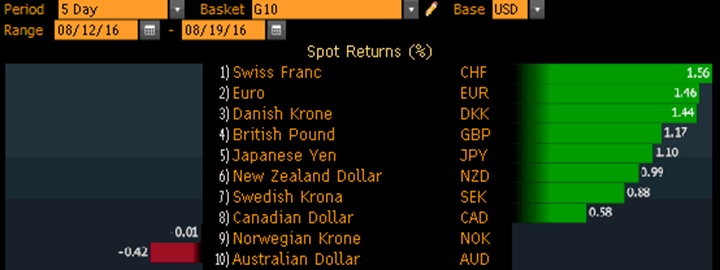The U.S. dollar traded lower against most of the major currencies this week, reaching a one month low versus the euro, British pound, Japanese yen, Swiss franc and Canadian dollars. The only currency that fared worse than the greenback was the Australian dollar. More on that later!
On a percentage basis, the losses were capped at 1.5% but what made the downtrend in the dollar so significant was its relentlessness. We see that through the Dollar Index which hit a 7-week low. Looking ahead, the main event of the week will be Janet Yellen’s speech at Jackson Hole on Friday. Before that, we anticipate sideways trading for the greenback. The only other currency with market moving data is the euro, which took a backseat last week.
US DOLLAR
Data Review
- FOMC Minutes Show Policymakers Divided
- Fed President Dudley and Williams Suggests that Rates Could Rise in December
- JPN GDP (QoQ) 0.0% vs. 0.2% Expected
- Empire State Manufacturing Index -4.21 vs. 2 Expected
- US Housing Starts 2.1% vs. 0.8% Expected
- Building Permits -0.1% vs. 0.6% Expected
- CPI (MoM) 0.0% vs. 0.0% Expected
- Philadelphia Fed Index 2.0 vs. 2.0 Expected
Data Preview
- Main Focus is Janet Yellen’s speech at Jackson Hole on Friday
- New & Existing Home Sales – Housing Activity likely to be supported by Low Interest Rates
- Markit PMIs – Stronger dollar could hurt manufacturing but recovery in jobs should boost services
- GDP Revisions – No major changes expected
Key Levels - USD/JPY
- Support 99.50
- Resistance 103.00

The U.S. economy is outperforming its peers and the Federal Reserve is the only major central bank not in easing mode but the U.S. dollar traders expected more. They had driven up the dollar last month after the recovery in non-farm payrolls and on the back of hawkish Fed comments, which revived hope for a 2016 rate hike. But after the surprise stagnation in retail sales, investors grew sceptical of the central bank’s resolve so even though most of this past week’s economic reports were better than expected, all of them were viewed with scepticism. This includes FOMC voter Dudley’s comment that rates could still rise in September and the hawkish FOMC minutes.
In the week ahead there’s not much in the way of market moving U.S. data. New home and existing home sales are scheduled for release along with Markit Economics’ PMI surveys, revision to Q2 GDP and the University of Michigan Consumer Sentiment Index. The main focus will be Janet Yellen’s speech at Jackson Hole on Friday. The selling pressure in the dollar is strong and for sentiment to change, we need Yellen to say that a rate hike is coming and we need to another unambiguously strong non-farm payrolls report. Even then, there’s zero chance of a rate hike in September or November. December though is open for discussion especially since it is a meeting where the Fed releases its latest economic projections and Janet Yellen delivers a press conference. If they were to raise rates this year, it would happen then, days before Christmas when Americans are well into their holiday shopping.
Unfortunately there’s still 4 months before the December meeting and there’s zero chance the Fed will raise rates in September or November. So in order for the dollar to bottom we need overwhelmingly positive data so until then dollar will continue to fall, consolidate for the next week or experience shallow bounces. USD/JPY is still struggling around 100 and while a move to 101 is possible, the chance of a new August high above 103 is unlikely. Also we could see numerous attempts below 100. At the end of the day, we believe the June low of 99 will hold but USD/JPY has set a new lower range.
BRITISH POUND
Data Review
- Prime Minister Theresa May Signals Plans to Invoke Article 50 by April 2017
- Post Brexit Data Not So Bad
- CPI (MoM) -0.1% vs. -0.1% Expected but Prices Rise YoY
- Jobless Claims -8.6K vs. 9K Expected
- ILO Unemployment Rate 4.9% vs. 4.9% Expected
- Average Weekly Earnings 2.4% vs. 2.3% Previous
- Retail Sales 1.5% vs. 0.1% Expected
Data Preview
- GDP Revisions – Generally not revised if changes are made it will be market moving
Key Levels - GBP/USD
- Support 1.3000
- Resistance 1.3300
One of the biggest risks this year was Brexit and even though it continues to be a sore topic, one of the main things that we learned this past week is that the damage so far of the U.K. economy has been limited. At the beginning of this past week, many investors feared that the first set of post Brexit data would be very weak and while they were right with regards to house prices, they were wrong everywhere else. U.K. consumer prices rose more than expected year over year, jobless claims declined, average hourly earnings increased and retail sales jumped 1.4% in the month of July. The Brexit induced weakness of the currency played a major role in boosting price pressures, attracting tourism and fuelling spending. However at the end of the week, UK Prime Minister May said Article 50 would be invoked by April 2017 and this confirmation sent GBP/USD tumbling. The U.K. calendar is light in the week ahead which means this headline could have a greater effect on the pound.
EURO
Data Review
- EZ Trade Balance €23.4b vs. €25.3b Expected
- GER ZEW Survey (Current Situation) 57.6 vs.50.2 Expected
- GER ZEW Survey (Economic Sentiment) 0.5 vs. 2 Expected
- EZ ZEW Survey (Current Situation) 4.6 vs. -14.7 Prior
- EZ Current Account €28.2b vs. €31.8b
- EZ CPI -0.6% vs. -0.5% Expected
- ECB sees less of a Brexit Impact than expected
- GER PPI 0.2% vs. 0.1% Expected
Data Preview
- Eurozone PMIs - Stronger industrial production and sharp rise in ZEW offset by lower factory orders so hard to say which way data will fare
- GE GDP Revision - GDP revisions are hard to predict but if changes are made, will be market moving
- German IFO Report – Business confidence likely to be stronger given recent data
Key Levels - EUR/USD
- Support 1.1200
- Resistance 1.1400
In contrast to the U.S. and U.K., there’s quite a bit of market moving data from the Eurozone next week. This includes the August PMIs, German IFO report and revisions to second quarter GDP. So far data from the Eurozone has been relatively healthy and regional officials have expressed their optimistic view that the impact of Brexit will be limited. Considering that U.K. PMIs took a nosedive recently, investors will be watching the Eurozone PMIs carefully. EUR/USD enjoyed a very strong rally this past and there’s no major resistance until the pre-Brexit high of 1.1425. However should the currency pair find itself back below 1.13, a deeper correction to 1.12 is likely.
AUD, NZD, CAD
Data Review
Australia
- RBA Minutes – Strong AUD a problem but low inflation could help
- Employment Change 26.2k vs. 10.0k Expected
- Unemployment Rate 5.7% vs. 5.8% Expected
- AUD Full Time Employment Change (JUL) -45.4k vs. 44.0k Previous
- AUD Part Time Employment Change (JUL) 71.6k vs. -33.2k Previous
New Zealand
- PMI Services 54.2 vs.56.4 Expected
- Employment Change (QoQ) 2.4% vs. 0.6% Expected
- Unemployment Report 5.1% vs. 5.3% Expected
Canada
- Retail Sales -0.1% vs. 0.5% Expected
- Retail Sales Less Autos -0.8% vs. 0.1% Expected
- CPI 0.0% vs. 0.0% Expected
Data Preview
Australia
- No Data
New Zealand
- Trade Balance Report - Potential for upside surprise given strong currency, drop in manufacturing PMI and new orders
Canada
- No Data
Key Levels
- Support AUD .7500 NZD .7100 CAD 1.2600
- Resistance AUD .7700 NZD .7350 CAD 1.3000
After selling off for 9 days straight, USD/CAD finally rebounded on Friday on the back of weaker than expected economic data. Retail sales dropped 0.1% in the month of June while consumer prices fell 0.2% - both releases were significantly weaker than expected. We believe USD/CAD has bottomed but at the end of the day, the fate of the Canadian dollar is tied to oil. Now that the commodity is trading above $48 a barrel, the next stop could be $50. The recent reversal in oil is driven by the hope that the Saudis will convince their peers to cut production at next month’s informal OPEC meeting. Considering that there’s still weeks to go before that meeting, the rise in oil is bound to lose momentum and when that happens, it will mark a near term bottom for USD/CAD. There are no major economic reports scheduled for release from Canada next week.
Meanwhile the worst performing currency this week was the Australian dollar, which lost value against all of the major currencies – including the U.S. dollar. The RBA minutes were uninspiring and their labour market report ambiguous. The RBA expressed concerns about the elevated AUD and the issues it would cause for the transition from the mining book but added that low inflation should help growth. There were no hints on whether rates will fall again. In terms of the labour market, job growth was strong enough to push the unemployment rate lower but all of the work gained was part time with full time jobs seeing the largest decline in 3 years. In contrast, New Zealand reported very healthy labour data and a sharp 12% rise in dairy prices. This divergence helped to drive AUD/NZD to its lowest level in nearly 3 weeks. Looking ahead there are no major economic reports scheduled for release from Australia and only the July trade balance from New Zealand. Technically both AUD/USD and NZD/USD are a near a peak and with the greenback expected to move sideways before Yellen’s speech on Friday, we may not seem much additional upside momentum.
Good luck to all.
